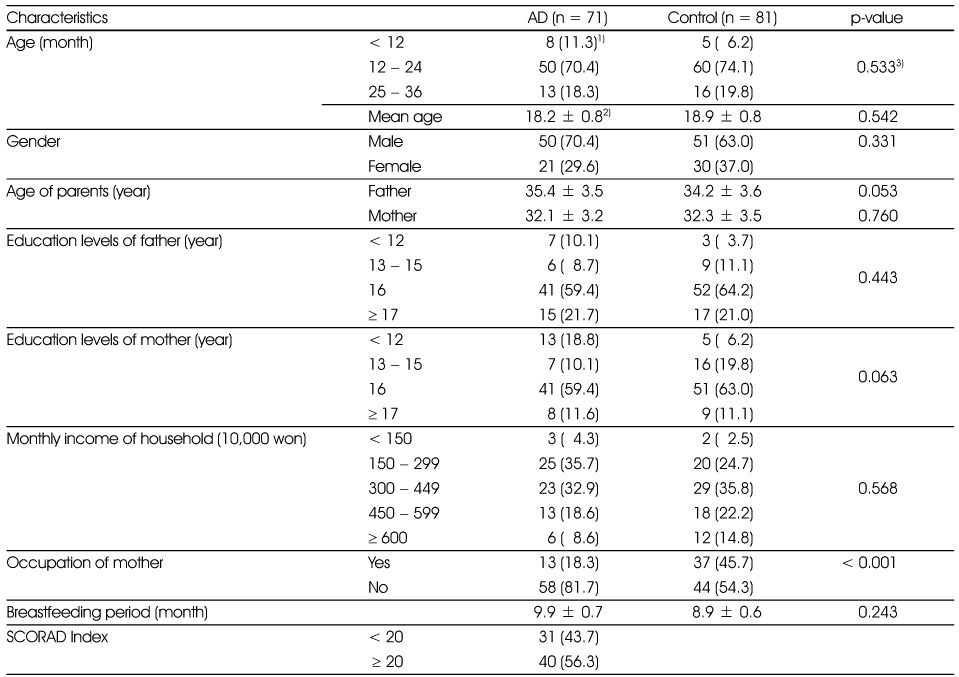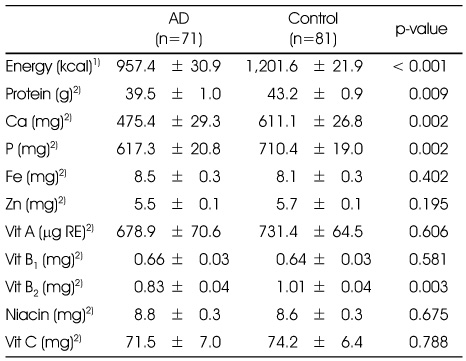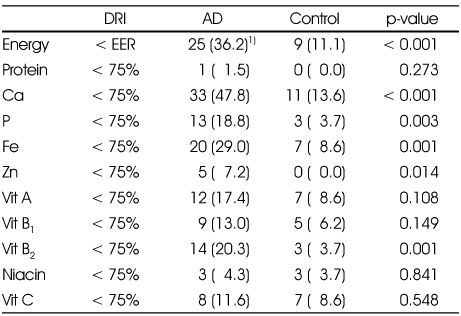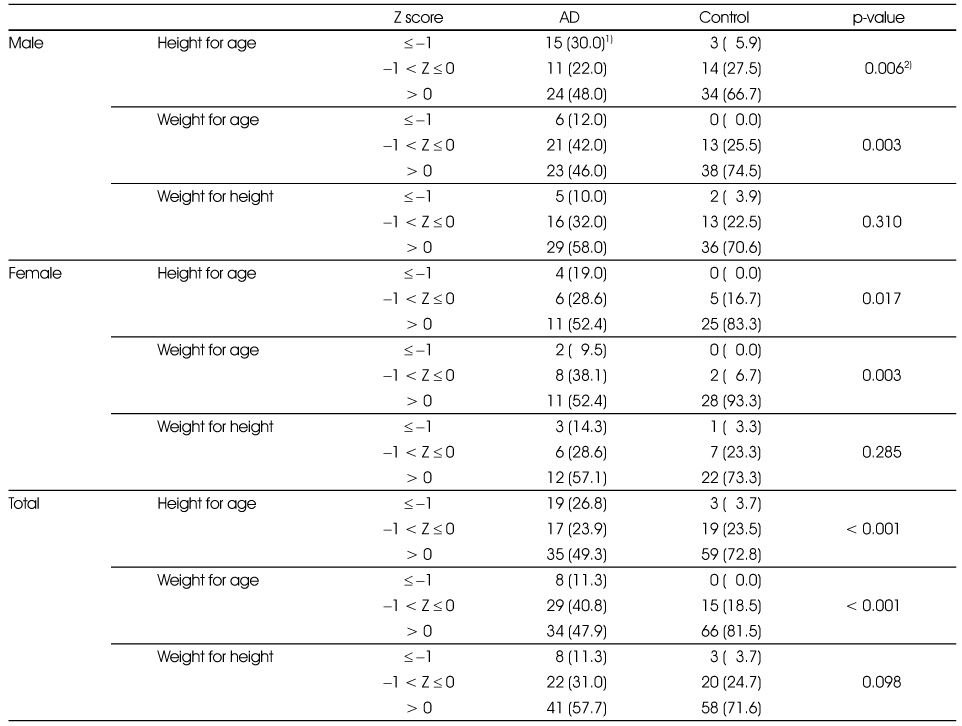References
1. Agostoni C, Grandi F, Scaglioni S, Gianni ML. Growth pattern of breastfed and nonbreastfed infants with atopic dermatitis in the first year of life. Pediatrics 2000. 106E73.
2. Ahn HS. Growth and development. Textbook of pediatrics 2007. 9th edth ed. Seoul: Daehan; 13–36.
3. Barth GA, Weigl L, Boeing H, Disch R, Borelli S. Food intake of patients with atopic dermatitis. Eur J Dermatol 2001. 11(3)199–202.
4. Baum WF, Schneyer U, Lantzsch AM, Klöditz E. Delay of growth and development in children with bronchial asthma, atopic dermatitis and allergic rhinitis. Exp Clin Endocrinol Diabetes 2002. 11053–59.
5. Burks AW, Mallory SB, Williams LW, Shirrell MA. Atopic dermatitis: clinical relevance of food hypersensitivity reactions. J Pediatr 1988. 113(3)447–451.
6. Chang EY, Chung SW, Lee JH. Mother's experience of caring child with a severe atopic dermatitis. Korean Parent Child Health J 2006. 9(1)17–32.
7. Chung SJ, Han YS, Chung SW, Ahn GM, Park HY, Lee SY, Cho YY, Choi HM. Marasmus and Kwashiorkor by nutritional ignorance related to vegetarian diet and infants with atopic dermatitis in South Korea. Korean J Nutr 2004. 37540–549.
8. Christie L, Hine RJ, Parker JG, Burks W. Food allergies in children affect nutrient intake and growth. J Am Diet Assoc 2002. 102(11)1648–1651.
9. Durmus B, van Rossem L, Duijts L, Arends LR, Raat H, Moll HA, Hofman A, Steegers EA, Jaddoe VW. Breast-feeding and growth in children until the age of 3 years: the generation r study. Br J Nutr 2011. 105(11)1704–1711.
10. Eigenmann PA, Sicherer SH, Borkowski TA, Cohen BA, Sampson HA. Prevalence of IgE-mediated food allergy among children with atopic dermatitis. Pediatrics 1998. 101(3)E8.
11. Greer FR, Sicherer SH, Burks AW. American Academy of Pediatrics Committee on Nutrition. American Academy of Pediatrics Section on Allergy and Immunology. Effects of early nutritional interventions on the development of atopic disease in infants and children: the role of maternal dietary restriction, breastfeeding, timing of introduction of complementary foods, and hydrolyzed formulas. Pediatrics 2008. 121(1)183–191.
12. Geneva. Physical status: the use and interpretation of anthropometry. Report of a WHO Expert Committee. World Health Organ Tech Rep Ser 1995. 8541–452.
13. Han YS, Chung SJ, Cho YY, Choi HM, Ahn GM, Lee SY. Analysis the food allergen sensitization in children with atopic dermatitis in Korea. Korean J Community Nutr 2004. 9(1)90–97.
14. Hanifin J, Rajka G. Diagnostic feature of atopic dermatitis. Acta Derm Venereol 1980. 92(S)44–47.
15. Isolauri E, Sütas Y, Salo MK, Isosomppi R, Kaila M. Elimination diet in cow's milk allergy: risk for impaired growth in young children. J Pediatr 1998. 132(6)1004–1009.
16. Kim JH, Lee HC, Jang JH, Ahn KM, Han YS, Lee SI. Risk factors influencing growth in children with atopic dermatitis. Pediatr Allergy Respir Dis 2008. 18(4)339–348.
17. Kristmundsdottir F, David TJ. Growth impairment in children with atopic eczema. J R Soc Med 1987. 80(1)9–12.
18. Kunz B. Clinical validation and guidelines for the SCORAD Index: consensus report of the European task force on atopic dermatitis. Dermatology 1997. 195(1)10–19.
19. Lee SI. Common allergic diseases in children. J Korean Med Assoc 2003. 46(3)231–243.
20. Lee SH, Lee HJ, Han YS, Ahn KM, Chung SJ. Excessive food restriction in children with atopic dermititis. Korean J Community Nutr 2011. 16(6)627–635.
21. Massarano AA, Hallis S, Devlin J, David TJ. Growth in atopic eczema. Arch Dis Child 1993. 68(5)677–679.
22. Ministry of Health and Welfare & Korea Center for Disease Control and Prevention. Korea National Health and Nutrition Examination Survey (KNHANESIV-3) 2010.
23. Niggemann B, Sielaff B, Bayer K, Binder C, Wahn U. Outcome of double-blind, placebo-controlled food challenge tests in 107 children with atopic dermatitis. Clin Exp Allergy 1999. 29(1)91–96.
24. Noimark L, Cox HE. Nutritional problems related to food allergy in childhood. Pediatr Allergy Immunol 2008. 19(2)188–195.
25. Oh JW, Kim KE, Pyun BY, Lee HR, Choung JT, Hong SJ. Nationwide study for epidemiological change of atopic dermatitis in school aged children between 1995 and 2000 and kindergarten aged children in 2003 in Korea. Pediatr Allergy Respir Dis 2003. 13(4)227–237.
26. Oh JW. Food and atopic dermatitis in children. Safe Food 2006. 1(2)18–24.
27. Palit A, Honda S, Bhalla AK, Kumar B. A mixed longitudinal study of physical growth in children with atopic dermatitis. Indian J Dermatol Venereol Leprol 2007. 73(3)171–175.
28. Sampson HA, McCaskill CC. Food hypersensitivity and atopic dermatitis: evaluation of 113 patients. J Pediatr 1985. 107(5)669–675.
29. Skolnick H, Barnes Koerner C, Connover-Walker MK, Sampson HA, Wood RA. The natural history of peanut allergy. J Allergy Clin Immunol 2001. 107(2)367–374.
30. The Korean Dietitian Association. Picture book for estimating food amount by looking 1999. Seoul:
31. The Korean Nutrition Society. Dietary reference intakes for Koreans, first revision 2010. Seoul: The Korean Nutrition Society;
32. Wahlgren CF. Pathophysiology of itching in urticaria and atopic dermatitis. Allergy 1992. 47(2)65–75.
33. Willett W. Nutritional epidemiology 1998. North Carolina: Oxford University Press;





